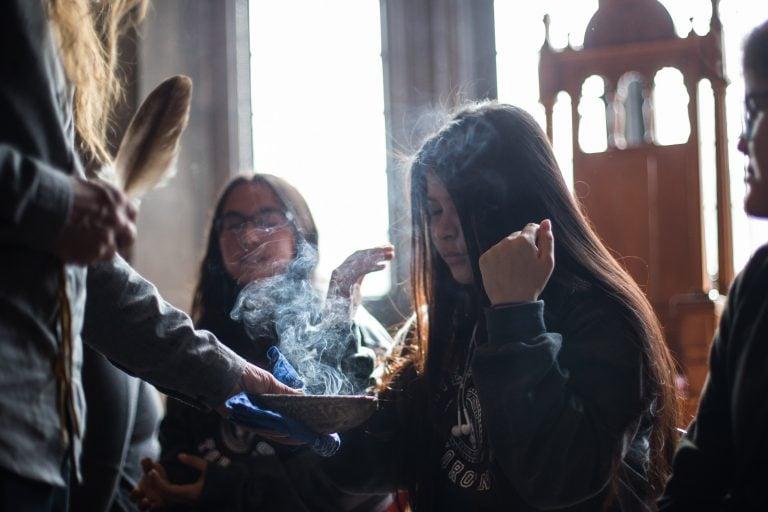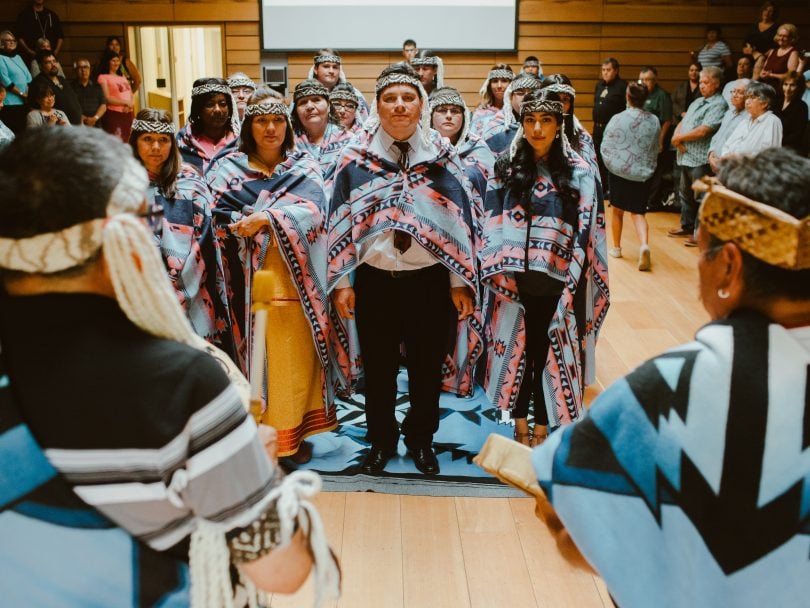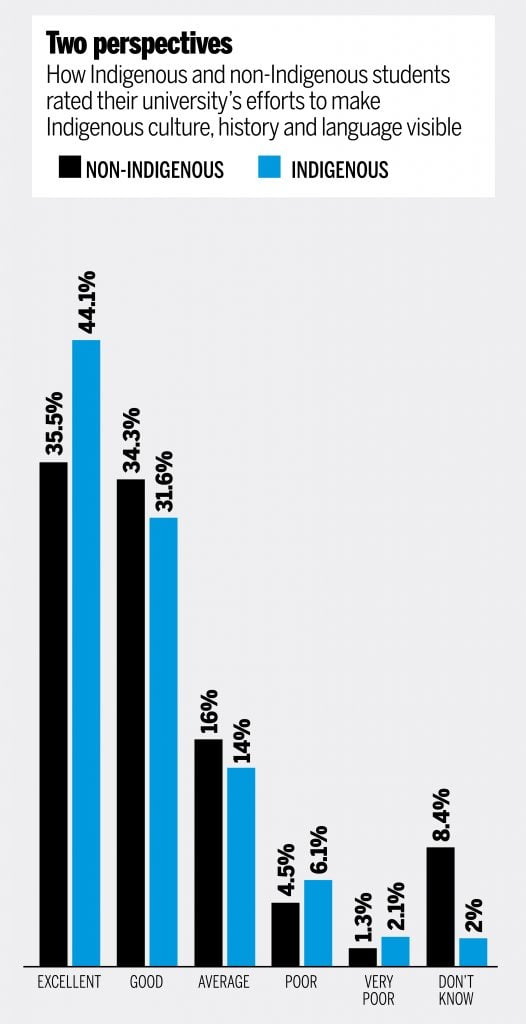How Canadian universities are responding to the TRC’s Calls to Action
Universities wrestle with how to begin their transformation—and what they’re willing to change

U of T’s Indigenization efforts include smudging rooms and a dedicated web portal (Jesse Winter/Toronto Star/Getty Images)
Share
Dalhousie’s Indigenous Student Centre recently relocated to a prominent place on the university’s downtown Halifax campus. Residing in a cheery blue house, shared by the Black Student Advising Centre, there’s a student lounge, computer lab and meeting/smudge room. On hand is an Indigenous student adviser to answer questions, serve as a sounding board and curate regular events, like a monthly communal meal that often includes traditional ingredients like moose meat. There’s also an elder-in-residence, and the centre provides tobacco ties—loose leaves collected in a small cloth and offered as a gesture of respect—in case students want to approach the elder for assistance.
Sitting in a room smelling of recently smudged sage and sweetgrass, Michele Graveline, Dalhousie’s Indigenous student adviser, describes an exercise recently added to the school year’s start for most incoming students to the professional faculties, including law, medicine and engineering.
The “blanket exercise” is an interactive workshop that explains Canadian history through an Indigenous perspective. Blankets are laid down and then gradually stripped away to symbolize the loss of land and the decimation of Indigenous perspectives through smallpox, residential schools, missing and murdered women and other forms of contact. Response to the workshop, designed by faith-based advocacy group KAIROS Canada in partnership with Indigenous elders and teachers, is mostly positive. Mostly. “There are still some students who ask why we have to do this,” says Graveline.
RELATED: A new network aims to connect and support Indigenous scholars
“It’s a very visceral, experiential way to understand the history of colonization of Canada and the impact it has on contemporary society,” says Brad Wuetherick, Dalhousie’s executive director of learning and teaching and co-chair of Dalhousie’s Indigenous advisory council. “A lot of people are concerned that for 150 years of Canada, this history was not taught.”
When the Truth and Reconciliation Commission (TRC) of Canada issued its Calls to Action in December 2015, it placed education at the centre of the country’s reconciliation process. Created following a settlement between the federal government and survivors of residential schools, the TRC issued 94 Calls to Action, including calls to eliminate educational and employment gaps between Indigenous and non-Indigenous Canadians, address the backlog of Indigenous students seeking a post-secondary education and incorporate Indigenous education into existing programming.

Many universities have embraced these calls with gusto, accepting them as an urgent and overdue reckoning. Institutions have focused on recruiting and retaining more Indigenous students, hiring Indigenous faculty and creating Indigenous spaces—like the new centre at Dalhousie. And while the field of Indigenous studies is certainly not new—Trent introduced its department in 1969, the first in the country—some universities are receiving increased funding, re-examining curricula and implementing mandatory study for all students of particular faculties. As this work continues, many universities still grapple with the question of how foundational their changes should be. In an interview last year with the CBC, University of Saskatchewan Indigenous studies professor and Cree activist Priscilla Settee questioned the process by proclaiming that it would have to extend beyond “just add Indigenous and stir.”
At the school where she teaches, which has one of the highest concentrations of Indigenous students in the country at 15 per cent, a new strategic plan aims to make Indigenization one of the core pillars of the educational experience. The school’s academic governance body passed a motion almost two years ago decreeing that each degree program should have significant Indigenous content—while not prescribing the precise form for the institution’s 17 colleges and schools. “It doesn’t look the same across the institution, but we do expect consultation with Indigenous communities, elders and students about what they want to see in the programming in their particular area,” says Peter Stoicheff, University of Saskatchewan president. Stoicheff says his institution is committed to the idea of “nothing about us without us,” and that research involving Indigenous peoples has become more consultative and symbiotic. “We put a lot of emphasis on researching Aboriginal peoples and on working with communities to do that kind of research appropriately and not just on the university’s terms,” he says. The university has also added Indigenous voices to governance roles, including an elders advisory council and the recent creation of a vice-provost for Indigenous engagement—a position held by Jacqueline Ottmann, an Anishinaabe scholar charged with transforming “practices inclusive of Indigenous leadership, methodologies and pedagogies.”
In its own bid to foster inclusion, the University of Toronto is launching a dedicated Indigenous web portal in October, hoping to highlight services available to and contributions made by Indigenous people on campus. The provost’s office at U of T also recently approved funding to support 20 Indigenous faculty hires and 20 Indigenous staff hires. “If we want the university to transform, we really need Indigenous people here in all aspects of university life,” says Jonathan Hamilton-Diabo, director of U of T’s Indigenous initiatives and the former director of First Nations House, which offers Indigenous student services.
RELATED: How Indigenous scholarship winners are busting myths and stereotypes
The changes being introduced by Canadian universities certainly feel like progress. But there are stickier parts, too. Hamilton-Diabo, who grew up in Kahnawà:ke Mohawk Nation in Quebec, warns schools must avoid “pan-Indigenization,” or the presentation of Canada’s Indigenous peoples as one monolithic bloc. “Indigenous peoples are a collection of people with diverse backgrounds and nations, and there are great differences. We are not all the same. It’s truth and reconciliation—and we can’t just focus on reconciliation. It means that the university has to build relationships with multiple peoples and communities.”
Hayden King, director of the Yellowhead Institute at Ryerson University, says that the concept of Indigenization is itself problematic. “It implies that we’re adding Indigenous peoples to existing institutions and structures and making them a bit more hospitable, but it doesn’t address the core structural issues of institutions like the university,” he says. “We can recruit more Indigenous students to campus and put Indigenous iconography on campus, which are all symbolic changes, but representation is only a partial remedy.”
Further, increasing representation can have its own perils. Indigenous peoples are significantly underrepresented in graduate work—just three per cent of master’s and Ph.D. students are Indigenous, according to Universities Canada. So how can institutions hire them into the university system and avoid leaving them languishing as underpaid, insecurely employed sessional teachers without challenging tenure requirements? And how can every aspect of the university, an inherently conservative institution, be enveloped in the process of Indigenization?
At Trent University, part of that transformation involves not simply inclusion of Indigenous narratives but the incorporation of Indigenous knowledge. David Newhouse, professor and chair of Indigenous studies at Trent, points to the Mi’kmaw concept of “two-eyed seeing,” a framework for fusing the best of Indigenous knowledge, led by Indigenous elders, with the best of Western knowledge.
Newhouse says that this process is actively countering the destruction perpetrated by residential schools. “The schools intended to turn Indians into Europeans, and so it was geared toward the elimination of Indigenous knowledge,” says Newhouse. “So in my view, this is one of the most profound statements that a university in Canada can make. It acknowledges that a people who have lived here for millennia have knowledge that is important and valid and is part of the academy.”
The idea of shifting the framework of all the university’s teachings, not simply adding more courses that examine Indigenous history, language or culture, is a core part of the reconciliation process for many Indigenous scholars. “Indigenization really has to recognize the validity of Indigenous worldviews and ways of knowing, being and doing. It has to recognize our knowledge and perspectives,” says Shelly Johnson, the world’s first Canada Research Chair in Indigenizing higher education and an associate professor at Thompson Rivers University in Kamloops, B.C. “Education was a weapon used against us to remove language and culture and traditions. What about putting back oral tradition, including elders as sources of knowledge, and recognizing Indigenous writers and scholars?”
The integration of Indigenous scholars into the typically rigid framework of post-secondary education has also proven thorny. At Dalhousie, the administration is presently navigating the tenure review process for a cohort of Indigenous professors whose research and dissemination methodologies vary from the established “publish or perish” norm. A new collective agreement with faculty recognizes Indigenous knowledge and aims to steer tenure committees toward greater latitude. “For Indigenous scholars, dissemination back to community, and the utility of that research for communities, is first and foremost,” says Dalhousie’s Wuetherick. “The idea of publishing a peer-reviewed journal article is not top priority.”
Funding—for Indigenous faculty and students, and for initiatives related to Indigenization—is a top priority, even if ambitions don’t always match resources. “The funding now available to First Nations students is inadequate,” says Newhouse. “The number of students who want to go to university is so great that the communities have to make decisions about administering those funds, and there’s a greater expectation of student or parental contributions, which is tough if you’re lower-income.”
Several universities dedicate portions of their operating budget to financial aid for Indigenous students and services like daycare. (A relatively high number of Indigenous students are parents.) They’ve also pursued grants big and small from both public and private sources. Last year, Vancouver Island University and Yukon College jointly received more than $20 million from the Mastercard Foundation to help Indigenous youth access post-secondary education through a range of initiatives, including financial support, mentoring and community engagement.
RELATED: How Canadian universities help fight to save Indigenous languages
Settee points to systemic economic barriers that extend beyond the university, including the rising cost of living and depleted social housing options. “For my Indigenous students, who tend to be the poorest of the poor, it impacts their lives greatly,” says Settee. “I had a call from a student the other day to tell me she wouldn’t be coming to class because she didn’t have money for the bus.”
For many institutions, this is just the start of a very long process—though of course the conversation has been going on much longer in Indigenous communities. “This is a very long-term project, and I have a mixture of patience and impatience,” says University of Saskatchewan’s Stoicheff. “We have to have constant dialogue, externally and internally, and we have to be moving not just in measurable ways but in ways that are experienced by Indigenous students and their communities.”
Some still find institutions resistant to change. Sandra Muse, a professor of Indigenous literature, resigned from Saint Mary’s University during the summer because of what she describes as an institution-wide refusal to implement Indigenization recommendations beyond “window dressing.” “I could have stayed and gotten tenure and had a pretty cushy life, but I couldn’t live with myself,” she says.
Muse has since landed at the University of Windsor, where she was part of a five-faculty cluster of Indigenous hires. Windsor also offers a Native Student Alliance, Aboriginal Education Council and a Brown Bag Series designed to encourage conversations about how to decolonize existing pedagogy. During one meeting in early September, Muse and her new colleagues formulated a plan to train other faculty members in certain processes related to Indigenization so that all of the work isn’t expected of recently hired Indigenous faculty members still awaiting tenure. “I feel much more hopeful here, like I can make a difference,” she says.

There are signs that progress is being made. According to a 2017 Universities Canada survey, 65 per cent of universities are incorporating Indigenous knowledge, methods and protocols into research and teaching policies, programs and practices, while 71 per cent are working to include Indigenous representation within their governance structures.

But making a significant difference will require intense examination of normative behaviour—something that’s bound to be uncomfortable. Johnson points out that TRU’s Indigenous Services are housed in an old army officer’s building that’s “probably the most colonial building on campus.” It’s hard, she says, to expect Indigenous students to overlook this even in their desire for support. “I think about the disrespect that’s inherent in that for people whose families were absolutely decimated by colonialism.”
Ultimately, says King, meaningful change will have to be driven by Indigenous students and faculty. “The trend is typically that more Indigenous students get into these universities, they begin to organize, more Indigenous faculty is recruited, the community grows, and the university is pushed on these issues.”
At Dalhousie, Wuetherick acknowledges that the students have been essential in pushing for change. “They’re not shy about holding the campus to account and encouraging more aggressive timelines,” he says. “They’re a big reason the new Indigenous Students Centre and elder-in-residence program came together so quickly.” This year, for the first time in Dalhousie’s 200-year history, the president of the student union is Mi’kmaw from Cape Breton. During orientation, each student received a small feather sticker that reads: “Dalhousie University is located in Mi’kma’ki, the ancestral and unceded territory of the Mi’kmak. We are all treaty people.”
Graveline, Dalhousie’s Indigenous student adviser, marvels at this development. “Dal has come out officially with a land acknowledgement, which seems like a simple thing, but it’s such a big piece. Just a few years ago, they wouldn’t have used the word unceded, and now it’s printed on syllabuses.”